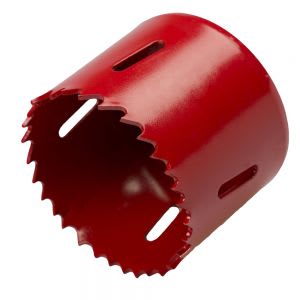Holesaws
(54 Products)Holesaws are essential tools for both DIY enthusiasts and professional tradespeople, designed to create perfectly round holes in various materials. These specialised saws consist of a circular steel blade with saw teeth along the edge. They attach to a drill via an arbour (also known as a mandrel) and a pilot drill bit, allowing for precise and efficient cutting. The pilot drill bit helps guide the saw and keep it steady during the cutting process.
What are Holesaws?
Holesaws are cylindrical cutting tools used to create holes with larger diameters than standard drill bits. They consist of a saw blade in the shape of a ring, with the cutting edge on the outer rim. The teeth on the blade perform the cutting, while the centre remains intact, creating a circular hole.
Key Components of a Holesaw
- Saw Blade: The ring-shaped blade with teeth that cut through materials.
- Arbour: The central shaft that attaches the holesaw to the drill chuck, also known as a mandrel.
- Pilot Drill Bit: A smaller drill bit located in the centre of the arbour, which helps guide the holesaw and prevents it from wandering during the cutting process.
Types of Holesaws
Bi-Metal Hole Saws
Bi-metal hole saws are made from two types of metal, typically high-speed steel (HSS) and a flexible steel alloy, offering enhanced heat and wear resistance. They are ideal for cutting metal, including stainless steel, cast iron, and sheet metal, as well as wood and plastics.
Carbide Hole Saws
Carbide hole saws have teeth tipped with carbide, known for its hardness and resistance to wear. They are suitable for cutting through harder materials like stone, tiles, masonry, and ceramics, providing a smoother and more durable cutting edge.
High-Speed Steel (HSS) Hole Saws
HSS hole saws are made entirely from high-speed steel, offering excellent cutting performance on softer materials like wood, plastic, and non-ferrous metals such as aluminium, copper, brass, and tubes. They are known for their sharpness and durability.
Applications of Holesaws
- Woodworking: Creating holes for door hardware, pipes, and wiring.
- Metalworking: Cutting holes in sheet metal, cast iron, stainless steel, and other metals.
- Plumbing: Drilling holes for pipes and tubing in various materials.
- Electrical Work: Making openings for wiring and electrical components in drywall, plaster, and other materials.
- Masonry: Cutting through stone, brick, and concrete for installations.
- General DIY Projects: Drilling holes for cable routing, fitting taps, making cutouts for light fixtures, and installing hardware.
Choosing the Right Holesaw
Selecting the right hole saw depends on the material you are working with and the diameter of the hole you need to create.
Holesaws come in various sizes, typically ranging from 14 mm (about 0.55 inches) to over 152 mm (about 6 inches) in diameter.
Factors to Consider
- Material: Choose a holesaw suitable for the material you are cutting. Bi-metal hole saws are versatile for most applications, while carbide hole saws are better for harder materials.
- Diameter: Ensure the holesaw matches the diameter of the hole you need. Measure accurately to select the appropriate size.
- Depth: Consider the depth of the cut required. Some holesaws are designed for deeper cuts, which is essential for thicker materials.
- Durability: Look for features like enhanced heat and wear resistance to ensure long-lasting performance.
Using a Holesaw
- Attach the Arbour: Secure the arbour and pilot drill bit to the holesaw.
- Set Up the Drill: Attach the arbour to the drill chuck.
- Position the Pilot Drill Bit: Place the pilot drill bit on the marked centre of the hole.
- Start Drilling: Begin drilling at a low speed to let the pilot drill bit guide the holesaw. Increase the speed as the saw starts to cut through the material.
- Apply Steady Pressure: Maintain steady pressure and let the saw do the work. Avoid forcing the holesaw, as this can damage the teeth and the material.
Maintenance and Care
To ensure the longevity of your holesaws, follow these maintenance tips:
- Clean After Use: Remove any debris or chips from the teeth and blade.
- Inspect for Damage: Check for worn or damaged teeth and replace the holesaw if necessary.
- Lubricate When Cutting Metal: Use cutting oil to reduce friction and heat when cutting metal.
Frequently Asked Holesaws Questions
Can Holesaws be Used with Standard Handheld Drills?
Yes, most holesaws can be attached to standard handheld drills. However, for larger holes, it is recommended to use a more powerful drill such as a drill press to ensure better control and stability.
How Does a Holesaw Differ From a Standard Drill Bit?
Unlike standard drill bits, which create smaller holes by removing all material within the hole diameter, holesaws cut larger diameter holes while leaving the core material intact.
This makes them more efficient for larger holes, producing cleaner cuts with less material wastage.
What Materials Can Holesaws Cut Through?
Holesaws can cut through a wide variety of materials, including wood, metal, plastic, tiles, stone, and masonry.
The type of holesaw you use (bi-metal, carbide, or high-speed steel) should be selected based on the specific material you are working with.

